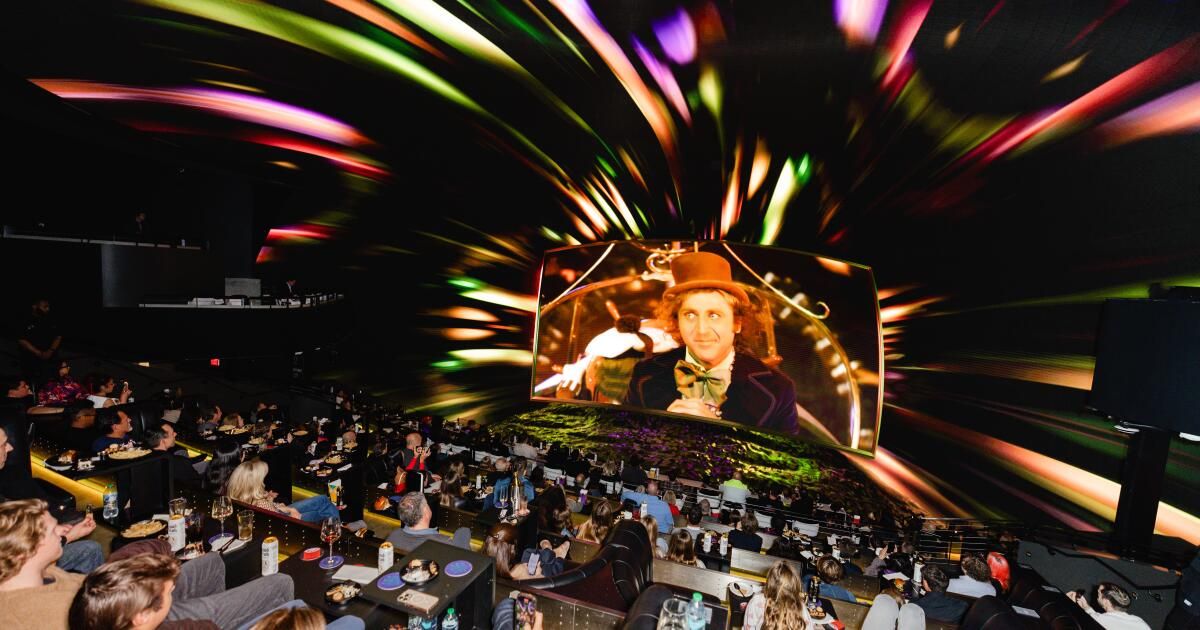We are at the dawn of the era of “experimental cinema.”
At least that's the proposal from entrepreneurs like Cosm's Jeb Terry and Sphere's James Dolan, whose vaulted theaters have embraced the idea of reviving old movies to augment them with new technology. Terry used the phrase Tuesday in his introduction to a revival of 1971's “Willy Wonka and the Chocolate Factory,” opening this week at the Cosm in Inglewood with modern CGI animation, aiming to emphasize the whimsical, childlike wonder of Gene Wilder's film.
“Wonka” is Cosm's second attempt at redefining the movie experience: “The Matrix” got the Cosm treatment last summer and “Harry Potter and the Sorcerer's Stone” will follow next year. Watching a movie in what the venue calls “shared reality” can be encompassing and yet intimate, communal, and, if all goes well, somewhat reflective. The 87-foot-diameter spherical screen wraps above, below and behind us, but the emphasis on couches invites a cooperative atmosphere. And guests are encouraged, for example, to pull out their phones and capture and share the moment.
The spherical screen can give the illusion of dimension.
(Cosmo)
It's a lot of fun, if you don't take it too seriously, as experiential, in the case of “Wonka,” means that a movie dedicated to the power of imagination sometimes leaves it a little less so. Lively and bright, Cosm's approach for “Wonka,” a collaboration with experiential firm Little Cinema and visual effects house MakeMake, is to ensure that audiences are never left surrounded by eye candy. The result is alternately charming and shocking: why, I wondered, isn't the animation done in a 1970s style to better complement the film?
In turn, has the film's new magic replaced its subtle mystery? Or is that the wrong question to ask at screenings meant to look like a social event, with chocolate pies filled with peanut butter mousse and bright red vodka drinks rimmed with gold glitter salt?

“Willy Wonka” is the second Hollywood film, after “The Matrix,” to be featured in Cosm.
(Cosmo)
Because this is experiential at its finest. The film's opening credits of chunky chocolate squirts are now accompanied by softened images that seem partly inspired by “Super Mario Bros.,” as tubes and pipes aim to place the audience inside a milk chocolate factory. It's cute and you'll find yourself diverting your attention from the framed movie screen to look at the animated, toy-like mechanisms. My only qualm here was that the edges of the filmed footage had been defined with bright, calm animation.
Elsewhere, the film's news reports stretch out to show us an entire, cartoon-like studio, scenes of children galloping on the sidewalk as additional assembly lines churn out chocolate beneath them, and the film's first major song-and-dance moment, “The Candy Man,” is now surrounded by carnival-inspired imagery of swirling Candy Buttons, slot-machine-like flowers, and gentle nudges to, if not sing along, at least pronounce the lyrics.
“Wonka,” a moderate hit when it premiered, grew in importance over time as Sammy Davis Jr. turned “The Candy Man” into a hit and second screenings on television made it vital for generations to come at home. It is, at times, deliciously demented, a family film with a strange, perhaps sometimes even a little sinister, edge. And yet, I attended the premiere of Cosm's “Wonka” not as a film critic but as someone curious about the growing movements in the immersive industry, interested more in how Cosm could use its technology to enhance, revitalize, or find ways to illuminate a second film.

In Cosm, when Charlie discovers his golden ticket, digital fireworks explode.
(Cosmo)
Enlighten is a key word, as when young Peter Ostrum as Charlie unwraps a chocolate bar with the long-sought golden ticket, the animated images around the framed screen burst into fireworks. I remember watching that scene as a child and feeling a little tense, fearing, perhaps, that the consuming crowd would snatch the ticket away. However, Cosm aims to turn “Wonka” into pure joy. That moment was a reminder of how much influence that supplementary material can have on the emotional tone of the film.
In that sense, Cosm's immersive ambitions differ from experiments of the past: interactive dalliances in the '90s that recently came back to life on Netflix (see “Black Mirror: Bandersnatch”), or more recent 4DX theaters with motion-enabled seats (see the light, water and wind effects of “Twisters”). Maybe that's why what I thought worked best leaned toward the more abstract, when, for example, the cartoonish cityscapes gave way to black and white pencil effects, or when the animations highlighted the madness of Wonka's factory rather than trying to flesh it out.

A whimsical scene with the Oompa Loompas.
(Cosmo)
I was distracted, for example, when Wilder's Wonka limped into his grand entrance, the timid building behind him now dwarfed by shiny, shiny warehouses. However, I was transfixed when Wilder's character near the end was framed in blindingly fast rays of light, or when Oompa Loompa's ancillary characters were rendered out of frame as colorful orbs that looked like strands of DNA.
'Willy Wonka and the Chocolate Factory' in Cosm
I feel it's important to note that it's been over two decades since I saw the original “Wonka.” Fresher in my mind are the more recent cinematic explorations of the material and characters. While I chose to revisit “The Matrix” before seeing that film in Cosm, I opted for a different approach with “Wonka,” and I think the likelihood of embracing what Cosm is attempting will increase exponentially by sticking to the source material. Having forgotten large parts of the film, I found myself conflicted (watching the original film or concentrating on Cosm's props), whereas with “The Matrix,” the material was fresh in my mind and I was therefore more comfortable wandering around and staring at the impressive dome screen.
And it's really impressive. When Charlie begins to float in Wonka's factory, Cosm lifts the film frame and surrounds it with bubbles. Soon, depending on your seat, you may find yourself looking up. Cosm's images are so sharp that they can sometimes simulate movement and dimension, and we become dizzyingly lost when the characters are trapped in a room seemingly without doors.
Elsewhere, Cosm gains buoyancy when Denise Nickerson's Violet transforms into a jumping blueberry. Another clever moment: when Charlie's wall of moving hands extends beyond the screen and begins waving to the audience.
It is in these cases that the film comes to life and Cosm's vision of experiential cinema no longer seems like a novelty and becomes an experience.

Gene Wilder's Willy Wonka and Julie Dawn Cole's Veruca Salt in “Willy Wonka and the Chocolate Factory,” presented by Cosm.
(Cosmo)












